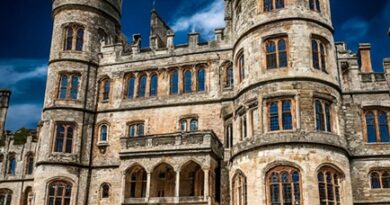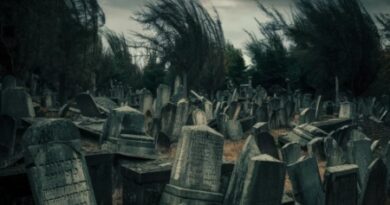Hill Of Crosses In Lituania: Death, Religion… And Crosses
According to the simplest and most basic definition, a cross is a shape of two perpendicular lines crossing each other. In practice, the crosses bring up different connotations and even entire myths. These are very ancient symbols, among the oldest known to humankind, and you will find additional uses for them in religions. As we know, a cross is the main symbol of Christianity, symbolizing the suffering of Jesus. In other concepts, the cross represents the division of the world into wind directions or the four elements, for example. And what about horror movies?
If you have seen horror movies, you probably know that the cross has a specific role in many. The cross, for example, is the object that can help us keep demons away from us (or possessed children. Yeah, like Regan), vampires (thanks to Buffy), and more creatures. Crosses can symbolize fear, evil, or a supernatural presence, but on the other hand, they also resemble hope, rescue, and healing. Historically, people used crosses as instruments of torture and death. When they are overturned, broken, or burned, another example, terrible events may occur. In many horror films, crosses appear in advance in scary locations, such as cemeteries, haunted houses, or dark churches.
Considering all these, it is possible to understand why a specific place containing an awe-inspiring number of crosses is considered scary, and therefore, we can include it on our site. This is precisely the case of the Hill of Crosses in Lithuania, which provides an exciting history and a specific scary side of the present.

What Is The Hill Of Crosses In Lithuania?
The Hill of Crosses (Lithuanian: Kryžių Kalnas) is located in the northern part of Lituania, about 12 kilometers from a city called Šiauliai, considered the fourth largest in Lithuania. As can be deduced from the name of the place and our introduction, on this small hill – which is about 60 meters long and only about 45 meters wide – you will find many crosses of various sizes and shapes. Along with statues, rosaries, pictures, and other objects, some religious and some related to Lithuanian history and nationality.
The Hill of Crosses is one of Lithuania’s most prominent pilgrimage sites, partly because it symbolizes hope, faith, and rebellion. Although the Hill of Crosses history is unknown, the accepted opinion is that the first crosses were placed there after the November Rebellion between 1830 and 1831. It was a bloody uprising in the occupied area of Poland and Lithuania against the Russian Empire.
The families of these victims could not bury their loved ones in the official territories due to the opposition of the Russian Empire and also because a large part of the bodies were never found. They decided to place the crosses on top of the hill, which slowly began to take on its character. Later, after the January Uprising in 1863, more and more crosses were added to it. Throughout history, the hill has received the status of a holy place where religious ceremonies occur.

Hill of Crosses Lituania has more than religious significance. When the Soviet Empire ruled Lithuania, it saw the place as provocative, as expressing the residents’ opposition to the regime, as a defiant place. More than once, the authorities attacked the hill and destroyed many thousands of crosses. Some were broken, others burned, and sometimes the government used the raw materials (mainly metal) for other purposes.
Later, the authorities imposed various restrictions on the place, including hermetically blocking access by physical means or with the help of the police, with claims of lack of value or even a raging plague. In the late 1970s, they even tried to flood the place. The Lithuanian residents did not raise their hands. Whenever the hill was damaged or destroyed, they worked to restore it.
How Many Crosses Are In The Hill Of Crosses?
The first mention of the Hill of Crosses, as far as we know, is in 1850, in writings that described 17 crosses. It is clear that over the years, the number has increased significantly, along with the changes that have taken place in the region and the Soviet Union in general. The restrictions were removed, or at least became less airtight, and the hill became a place of pilgrimage. At the same time, its religious-Catholic role became more visited, partly thanks to a visit to the site by Pope John Paul II in 1993, who preached a sermon of hope to the people of Lithuania and all Christian Europeans.
The crosses began to be counted more officially in 1900; according to the reports, there were 130. In the following years, we saw a “natural” increase in the number of crosses and, on the other hand, their reduction due to the same acts of destruction by the Soviet authorities. In 1922, for example, 50 crosses were counted here, while in 1938, the number exceeded 400. Additional counts, including in the 1960s and 1970s, indicated thousands of crosses despite (and perhaps because of) the destruction attempts of the Soviet government.

The exact number of crosses is unknown today, but estimates speak of more than 100,000 crosses at least, with the number increasing yearly. Some even think there are about 200,000-300,000 crosses here. It is important to emphasize that today, there are no regulated regulations or restrictions regarding who can place crosses on the hill or what type of crosses you can see there. This fact contributes to the charm of the place, or if you like, to its creepy atmosphere.
The feeling described by people who have visited here is chaos, which shows that death is everywhere. Large crosses stand out next to the smaller ones (as far as we understand, there is a maximum size of a cross), and the materials are varied (from simple wooden crosses to more luxurious metal crosses). You will find many decorations, carvings, paintings, photos of the deceased or texts, and sometimes small gifts next to them. In addition, according to local regulations, it is forbidden to remove a cross that is already here.

Some of the crosses include names or dates, either of ordinary people or the more holy ones, or even some heroes of the Lithuanian people. Some crosses correspond to the most terrible moments in the history of Lithuania or even the entire Baltic region. In 1994, the Estonia ferry disaster occurred, considered the deadliest maritime disaster of a ship in European waters. On that terrible day, a ferry with over 1,000 passengers sank in the waters of the Baltic Sea, killing 852 people. It is not entirely clear what happened in that accident when there are claims of a mysterious collision in the middle of the sea alongside the official version about the ship’s design deficiencies. Among all these discussions, over the years, a cross was placed here in memory of the victims of the disaster.
What Makes The Hill Of Crosses In Lituania Scary?
The next question you may ask is if The Hill of Crosses Lituania dangerous? Well, the answer is probably no. However, many see the Hill of Crosses as a scary site because of the atmosphere of death or the hill’s visual appearance. Similarly to other historical sites, such as the Jewish cemetery in Prague, the feeling here is that something is not quite right. At night, when the place is almost entirely dark, you can imagine everything we don’t like to imagine.
In a way that might not surprise you if you’ve read some of the previous reviews of spooky historical sites on our site, the Hill of Crosses in Lithuania also has its ghostly history. Some people believe Hill of Crosses Litaunia is haunted, so you can encounter the ghosts of those who died or were buried there. People claim that the spirits of fallen soldiers have been hiding here since the 14th century. Others can swear that those who haunt the hill are monks.
Occasionally, there are reports of energetic changes, a feeling that someone is watching them, visions, voices, or other scenes that look like they came out of a horror movie. As far as we know, this is mainly an imagination or a mythology that often develops in places of this type.

How Can You Visit Lituania Hill Of Crosses?
Hill of Crosses Lituania is reasonably accessible to people visiting Lithuania, emphasizing the north of the country, and can be reached quite easily by car (the hill is visible from the highway). The hill is open to visitors all year round, free of charge – and without a door or fence. There is no official entrance or ticket office, although nearby, you will find parking and a small souvenir shop, where you can stock up on crosses you can place on the hill.
If you want to visit the Hill of Crosses, you have several options. You can take a bus or a train from Vilnius or Kaunas to Šiauliai, and then take a local bus or a taxi to the hill. You can visit here independently. Some choose to place crosses and other objects here, and several information boards and signs explain the place. Some people will argue that all these do not justify coming to the site, even if you come here specifically. There is a lot to see and do in Lithuania, but the average tourist will likely not choose to fly to the Baltic country mainly to see the Hill of Crosses.
Those who want to understand more about the story of the place and its fascinating history can join a guided tour departing from various cities throughout Lithuania – not only nearby Šiauliai but also Vilnius, Kaunas, and Riga. These tours usually combine other essential sites in northern Lithuania, with the price including transportation, tutorials, and entrance fees (in places where they are needed).
Here are some of the availabale tours:





